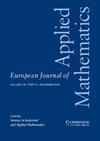网络动力学的波动响应模式——导论
IF 1.1
4区 数学
Q1 MATHEMATICS, APPLIED
引用次数: 0
摘要
网络化动力系统,即通过非平凡的相互作用拓扑耦合的动力单元系统,构成了一系列复杂系统的模型,从我们细胞中的基因调控和代谢回路到跨大陆传播的流行病。大多数这样的系统是由来自环境的不规则和分布的波动输入信号驱动的。然而,网络动力学系统如何共同应对这种波动取决于驱动信号的位置和类型、交互拓扑结构和其他几个因素,迄今为止在很大程度上仍是未知的。作为一个关键的例子,现代电网正在向更可持续的系统进行快速而系统的转型,可再生能源的渗透率很高。这些反过来又引入了电力输入的显著波动,从而对电网系统的稳定运行构成了直接挑战。电网系统如何动态响应波动的电力馈入以及其他时间变化,对于确保电网的可靠运行至关重要,但尚不清楚。在这项工作中,我们系统地介绍了波动驱动的网络动力学系统的线性响应理论。所提出的推导不仅提供了网络动态响应的近似分析描述,更重要的是,还可以提取时空分布响应模式的关键定性特征。具体而言,我们提供了扰动网络动力系统的LRT的一般公式,解释了动态网络响应模式是如何从线性化响应动力学的解中产生的,并强调了LRT在预测和理解不同时间和空间尺度上的电网响应以及对各种类型扰动的响应中的作用。从一般的数学角度理解这些模式可以快速直观地估计网络响应,并为电网运行、控制和设计等制定指导原则。本文章由计算机程序翻译,如有差异,请以英文原文为准。
Fluctuation response patterns of network dynamics – An introduction
Networked dynamical systems, i.e., systems of dynamical units coupled via nontrivial interaction topologies, constitute models of broad classes of complex systems, ranging from gene regulatory and metabolic circuits in our cells to pandemics spreading across continents. Most of such systems are driven by irregular and distributed fluctuating input signals from the environment. Yet how networked dynamical systems collectively respond to such fluctuations depends on the location and type of driving signal, the interaction topology and several other factors and remains largely unknown to date. As a key example, modern electric power grids are undergoing a rapid and systematic transformation towards more sustainable systems, signified by high penetrations of renewable energy sources. These in turn introduce significant fluctuations in power input and thereby pose immediate challenges to the stable operation of power grid systems. How power grid systems dynamically respond to fluctuating power feed-in as well as other temporal changes is critical for ensuring a reliable operation of power grids yet not well understood. In this work, we systematically introduce a linear response theory (LRT) for fluctuation-driven networked dynamical systems. The derivations presented not only provide approximate analytical descriptions of the dynamical responses of networks, but more importantly, also allow to extract key qualitative features about spatio-temporally distributed response patterns. Specifically, we provide a general formulation of a LRT for perturbed networked dynamical systems, explicate how dynamic network response patterns arise from the solution of the linearised response dynamics, and emphasise the role of LRT in predicting and comprehending power grid responses on different temporal and spatial scales and to various types of disturbances. Understanding such patterns from a general, mathematical perspective enables to estimate network responses quickly and intuitively, and to develop guiding principles for, e.g., power grid operation, control and design.
求助全文
通过发布文献求助,成功后即可免费获取论文全文。
去求助
来源期刊
CiteScore
4.70
自引率
0.00%
发文量
31
审稿时长
>12 weeks
期刊介绍:
Since 2008 EJAM surveys have been expanded to cover Applied and Industrial Mathematics. Coverage of the journal has been strengthened in probabilistic applications, while still focusing on those areas of applied mathematics inspired by real-world applications, and at the same time fostering the development of theoretical methods with a broad range of applicability. Survey papers contain reviews of emerging areas of mathematics, either in core areas or with relevance to users in industry and other disciplines. Research papers may be in any area of applied mathematics, with special emphasis on new mathematical ideas, relevant to modelling and analysis in modern science and technology, and the development of interesting mathematical methods of wide applicability.

 求助内容:
求助内容: 应助结果提醒方式:
应助结果提醒方式:


